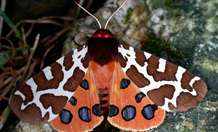Shedding light on moths: Whiter street lighting attracts more moths, but some like it more than others

Like their more visible cousins the butterflies, moths are undergoing rapid population declines.
In the case of butterflies these are clearly related to widespread habitat modification but moths also have to compete with lighting at night which can dramatically disrupt their behaviour.
Scientists from Biosciences at the University of Exeter's Tremough Campus, in collaboration with Cornwall College, Newquay, and Spalding Associates, Truro, studied the impact of different wavelengths of light on moths.
The research shows that shorter wavelength street lighting, which appears whiter and emits ultraviolet light, is more attractive to moths than longer wavelength - more yellow - street lighting. The research, published in the journal Biology Letters, also found that not all moths are equally attracted to shorter wavelength lighting. Certain families and species of moth showed no preference for either lighting type.
Robin Somers-Yeates, from the University of Exeter's Centre for Ecology and Conservation said: "We found that moths that usually fly at night were particularly likely to be attracted to the whiter light. It is not clear why these noctuid moths prefer the shorter wavelength light but the difference between families is interesting; the variation in how attractive different wavelengths of light are among moths may help to explain differences in the rate of population change between moth groups."
The paper can be found at the following link: rsbl.royalsocietypublishing.or … .1098/rsbl.2013.0376
Journal information: Biology Letters
Provided by University of Exeter



















